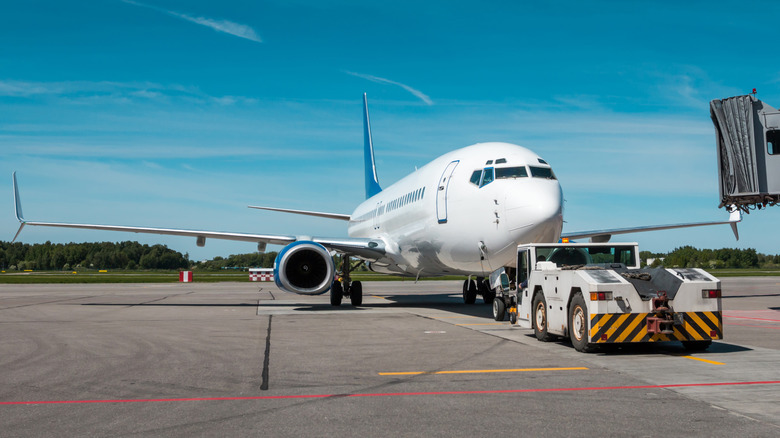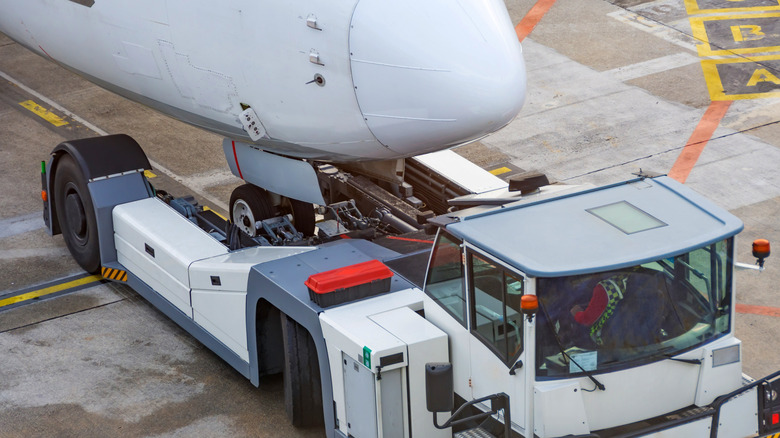How Heavy Are Aircraft Tugs And How Much Weight Can They Pull?
When soaring miles above the ground, an aircraft is in its natural habitat. Graceful and agile, modern planes can cross oceans and continents without missing a beat. However, when on terra firma, the story is different. When on the ground, aircraft — especially large airliners — can be like a fish out of water. Clumsy and difficult to maneuver, airplanes frequently require the assistance of aircraft tugs to help them navigate busy airports. Modern aircraft are no lightweights either. For instance, even a smaller commercial jet like the Boeing 737-Max 8 has a maximum takeoff weight of 181,200 pounds. For comparison, an Airbus A380 can weigh as much as 1,268,000 lbs at takeoff. To tow such weights around is no mean feat and the tugs that manage it are central to the traffic management of modern airports.
But just how much weight can airport tugs pull, and how heavy they have to be depends on the make and model. The International Air Transport Association (IATA) uses four categories to describe the operating parameters and maximum weight of an airport tug. A category one tug can handle aircraft weighing less than 110,000 pounds and has a minimum weight of 8,800 pounds. At the top of the order are category four tugs, these can manage aircraft more than 573,195 pounds and have a minimum weight of 88,184 pounds.
Airplane tugs - weights and pulling capacities
Aircraft tugs are designed to maneuver craft that physically dwarf them. However, try pulling an Airbus A380 with a tug designed for private aircraft and it will only end one way, badly. This is why busy airports will usually have a range of different tugs. For instance, at the lower end of the scale is the Eagle TT-6. This is a smaller tug that is designed to move business jet-sized aircraft like the Challenger 650 from Bombardier, one of the best private jet manufacturers. The TT-6 is rated to handle aircraft of weights up to 85,000 pounds, and the tug itself weighs in at between 8,100 pounds and 8,800 pounds depending on configuration. By comparison, a tug capable of handling an airliner like the Airbus A380 needs a lot more muscle and weight. An example of such a tug is the Schopf F396. Depending on the installed ballast, this can weigh anywhere between 99,208 and 165,347 pounds. This type of tug also has the advantage of being able to cope with all wide-bodied aircraft.
However, many regional airports mainly cater to smaller jets like the Boeing 737 Max or the Airbus 320. For these airports, a tug like the Schopf F396 could be considered overkill. A popular example of a medium-range tug is the TLD TPX-200-MT model. Weighing in at 26,400 pounds, this tug is designed to move up to 600,000 pounds and can cover a wide range of aircraft from the Airbus A319 right through to the wide-bodied Boeing 777-300.
Airplane tugs - Other design considerations
For an airplane tug to maneuver massive planes, there is more than the tug's weight to consider. Other design aspects also contribute to its effectiveness — traction, maneuverability, braking systems, and even how the aircraft is connected all matter. In the latter case, towbarless tugs — as the name suggests — eliminate the need for towbars. Instead, they lift the wheel from the ground and effectively become the plane's front wheels. This also reduces the need for multiple towbars to accommodate different aircraft models.
Traction and maneuverability are also important factors in aircraft tug design. Airplane tugs can feature three different steering modes to help with maneuverability: front-wheel steering, four-wheel steering, and crab-steering. However, maneuverability on its own means nothing without traction, this is where the weight comes in and why some tugs have ballast systems. Towbarless tugs use the weight of the airplane's front landing gear as the required "ballast," while tugs using a towbar may need to add ballast. Additionally, airplane tugs can feature all-wheel drive (AWD) systems to provide better traction. Braking systems are equally critical, with many tugs using hydraulic multi-disc brakes or regenerative braking systems to safely stop enormous loads.
They may not leave the ground, but airplane tugs are vital cogs in the complex choreography of modern air travel. These tugs can give even the largest planes the assistance they need to find their way to the runway and let them return gracefully to their natural habitat.


